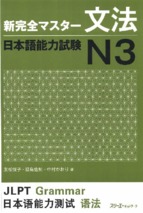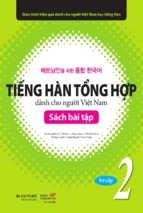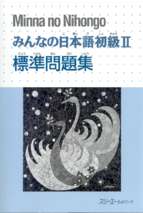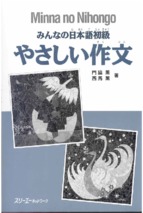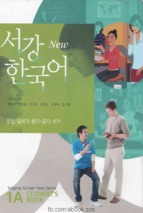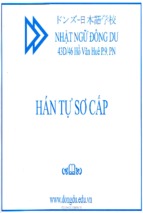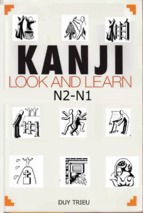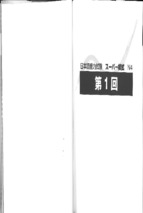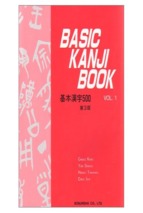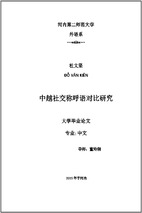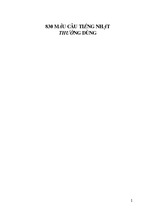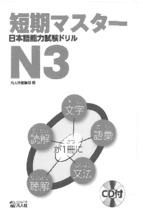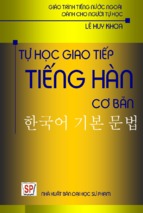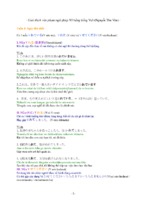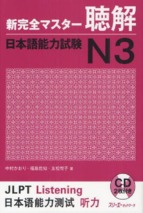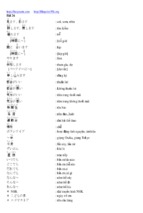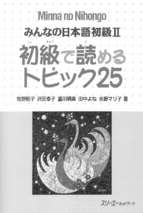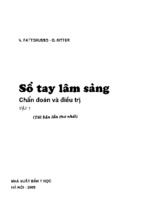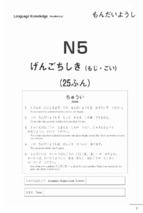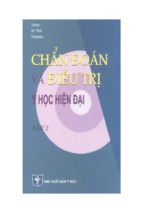Thuvientailieu.net.vn
Intermediate College Korean
㌠œ∑é ›‹
Thuvientailieu.net.vn
ôç
≠¡e
›∑
Bk@
íá
Ω÷
Ϸ
LÌ
≥å
nZ
Q÷/L÷
∞÷
œ∑ö kÚ®ì Korea and Neighboring Countries
Thuvientailieu.net.vn
Intermediate College Korean
㌠œ∑é ›‹
Clare You
Eunsu Cho
University of California Press/Berkeley, Los Angeles, London
Thuvientailieu.net.vn
University of California Press
Berkeley and Los Angeles, California
University of California Press, Ltd.
London, England
© 2002 by
The Regents of the University of California
Library of Congress Cataloging-in-Publication Data
You, Clare.
Intermediate college Korean = Taehak Han'gugo chunggup / Clare You, Eunsu Cho.
p. ; cm.
Includes index.
ISBN 0-520-22295-4 (pbk. : alk. paper)
1. Korean language —Textbooks for foreign speakers—English. 2. Korean language —
Study and teaching—English speakers. I. Title: Taehak Han'gugo chunggup. II. Cho, Eunsu,
1958– III. Title.
PL913.Y595 2002
495.7'82421—dc21
2001027084
Manufactured in the United States of America
09
08
10
9
07
8
7
06
05
6
5
04
4
3
03
02
2
1
The paper used in this publication meets the minimum requirements of ANSI/NISO Z39.48 -1992
(R 1997) (Permanence of Paper).
Thuvientailieu.net.vn
ó»
Contents
Preface ix
Acknowledgments xiii
Using the Text xv
Abbreviations and Symbols
Lesson 1
Lesson 2
Lesson 3
Lesson 4
Lesson 5
Lesson 6
Lesson 7
Lesson 8
Lesson 9
xix
ëfi‡üL
On the Airplane
1
LÌ
Seoul
9
∑≠
The First Day of Class
23
eB◊kM
Part-Time Job
32
B∂Àf ãL
Conversation with Friends
40
›M
Ch’usök
50
Lˆ≥À √Ârá
Kangwön-do and Lady Shin
61
öŒ ≥¡ ãú
Taejön, the City of Science
74
©ôk «Ï?
What Shall I Be?
84
Thuvientailieu.net.vn
vi
ó»
Lesson 10
Lesson 11
Lesson 12
Lesson 13
Lesson 14
Lesson 15
Lesson 16
Lesson 17
Lesson 18
Lesson 19
Lesson 20
Lesson 21
Lesson 22
Lesson 23
Lesson 24
Lesson 25
CONTENTS
Ü‘À f∑ √L
Kyöngju and the Foundation Myth of Silla
95
’∂ ≥¡E °eL
Calling on the Port City
106
∑öf ≥¡ ¢‘
Kwangju, the City of Arts
114
§‘≥
Cheju Island
124
R≠
New Year’s Day
132
Èü yõ
Song Contest
141
›π∂m £k
Saint Valentine’s Day
154
ãÈ« Pd
Presidential Election
165
J‰Ω
Hong Kil-dong
176
\f ò™ ∑Ä
Music Concert Reservation
186
¥Pµ Œ˚öf W∞
Meeting a Korean-Chinese Student
196
úy §Æk çÖ®x
Electrical Gadget Goes Wrong
207
©® W ȮZ Õx
Interpreting for a Trading Company
218
cπÀ ¢W ]ÀüL
Computer Information Center
227
?∑üL ¿ q¬
News from the United States
236
◊W ¿}ö íL ò‘
Idiot Ondal and Princess Phyönggang
245
Thuvientailieu.net.vn
ó»
Lesson 26
Lesson 27
Appendix 1:
Appendix 2:
Appendix 3:
Appendix 4:
Appendix 5:
CONTENTS
vii
nœü ãÕß
About North Korea
253
¡E GÒÕá
Reading Poems
261
|¥ÂÀ c@Â
Case Markers and Postpositions
267
QM‡ ™Ï ¥y˚
Easily Misspelled Words
270
áé Q‡
Spacing between Words
275
Ω£
Verb Charts
277
†rÂ
Connectives
284
¨˙ö ¨˚ Ùm
Patterns and Grammar Notes Index
289
{é Ùm
Glossary 305
Thuvientailieu.net.vn
This page intentionally left blank
Thuvientailieu.net.vn
Preface
Intermediate College Korean is intended to continue the development of the
Korean language skills of college students who have had previous training in basic Korean. Through our experience in teaching Korean at all
levels, we have found the intermediate level to be the most challenging
not only for instructors but also for students. Instructors must adapt to
widely varying degrees of language proficiency within a class. Students may
under- or overestimate their own linguistic abilities. Some students may
speak fluently but be completely unable to read and write in Korean, or
vice versa. In contrast to the introductory level, in which students begin
knowing nothing and end knowing something, this intermediate-level
journey may seem slower and more tedious for both instructors and students because progress is not as immediately apparent.
The intermediate level is, however, a transitional journey that students
must make if they are to reach an advanced level of proficiency. To assist
in that, this textbook challenges students to improve their vocabulary, syntax, and oral fluency as they read, hear, and talk about Korean cultural
themes. Of particular importance at this level of study is the expansion
of vocabulary, including the idiomatic applications of words and phrases.
This component is the single most important one in learning a language,
since knowing or not knowing a word can make a critical difference in
one’s communicative competence.
Acknowledging language to be a fundamental component of culture,
we have chosen to incorporate themes of Korea’s physical geography and
Korean culture as a contextual setting for each chapter. As the table of
contents indicates, the first half of the text includes visits to the major
cities, islands, provinces, and historical sites of Korea, while the second
ix
Thuvientailieu.net.vn
x
PREFACE
half focuses mainly on Korean culture and customs presented in the form
of college students’ dialogues, anecdotes, short essays, and simple poems.
In general, each of the twenty-seven lessons has four components. The
first component is the main text, which includes a short narrative, an accompanying situation dialogue, and, in many lessons, an optional reading (with its own vocabulary list). Only the later lessons (24, 25, 26, and
27) have no dialogue. The second component deals with the lesson’s vocabulary. The third component, patterns and grammar notes, highlights
the newly introduced idiomatic phrases, sentence endings, patterns, and
grammatical points, usually accompanied by examples with English translations for ease of comprehension. Avoiding linguistic jargon, this part of
the lesson gives simple explanations when necessary. Some aspects or types
of sentences are listed more than once because they are important or vary
in usage or because they are difficult to master in one setting—for example, forms of reported speech in Lessons 5, 6, 9, and 20. The final lesson
component consists of exercises for reading and listening comprehension,
vocabulary usage, and pattern application and suggested topics for group
discussion. In several lessons, supplementary notes in English provide information on topics, people, and places introduced in the lesson.
The approach to learning Korean in this text differs in several ways
from that in other textbooks:
1. This text draws on the geographic and cultural setting of
Korea by following a Korean-American student’s life in Korea.
It introduces students to current social issues and realistic
situations.
2. Through readings and dialogue, it introduces students to
college- and adult-level words that are ubiquitous in the news
and in the professional world, rather than dwelling on daily
survival words. The vocabulary ranges from computer-related
language to terms from the martial arts.
3. Each lesson presents both the written and the spoken language,
which are quite different in Korean. A third of the lessons
include optional reading for those who are more advanced
and who want an extra challenge.
4. This text provides maps of Seoul and of Korea, including South
Korean major highways, that are useful in certain lessons.
Thuvientailieu.net.vn
PREFACE
xi
5. In the back of the book, helpful reference materials include a
glossary, an index to the patterns and grammar notes, a list of
case markers and postpositions, tips on spelling and on spacing
in Korean words, verb charts, and a list of connectives.
6. An accompanying workbook and weekly homework packet
are available from Clare You:
[email protected] and
Eunsu Cho:
[email protected]. The workbook supplements
exercises with additional frequently used vocabulary, classroom
activities, and weekly assignments. It includes 100 basic hanja
(Sino-Korean characters) for optional learning.
Having taught Korean classes using the introductory College Korean
book, we understand the need for fresh material to expand on the themes
of that beginning-level text while maintaining continuity with it. Since we
drafted this new text three years ago, we have successfully used it in intermediate-level courses at the University of California at Berkeley and
the University of Michigan.
Thuvientailieu.net.vn
This page intentionally left blank
Thuvientailieu.net.vn
Acknowledgments
The approach in this text originally developed out of our years of experience teaching intermediate Korean language courses. We have tried
many of the available textbooks for this level, and we owe much in particular to the ones developed by Korea University, Sogang University, Seoul
National University, and Yonsei University. Without them, our task of
teaching intermediate Korean would have been even more challenging.
Drawing on our use of those books in the classroom, we designed this text
for the specific needs of our students. Another important influence, as
we shaped the content of this book, was Professor Claire Kramsch of the
University of California at Berkeley, especially in her book Context and Culture in Language Teaching. Much credit is also due to ∑¨˚ (Korean Grammar) by Seung-su Seo and to œ∑f êé (The Language of Korea) by IkSeop Lee et al. for our grammatical notes.
We offer our deep gratitude to the many people who provided their
direct assistance in finalizing this text. We are grateful to Professor Ki-joong
Song of Seoul National University for his critical reading and valuable comments. Our special recognition is due to Kyung-hwan Mo and In-taek Han,
graduate instructors at the University of California at Berkeley, for their
critical comments, revisions, and proofreading after each classroom trial
of the text, and to Jee-hyun Park, lecturer at the University of Michigan
for the same task and for last-minute proofreading. We wish to thank our
graduate instructors at both universities, Seung-joo Lee and Dae-won Lee
of the University of California and Yookyong Lee and Chang-yong Choi
of the University of Michigan, for assisting us in various stages of the textbook development. Also, we thank Kay Richards, coauthor of the introductory College Korean, for her encouragement and support. Finally, we wish
to thank Laura Driussi, Suzanne Knott, Sheila Levine, and Linda Norton
of the University of California Press for making this publication possible.
xiii
Thuvientailieu.net.vn
This page intentionally left blank
Thuvientailieu.net.vn
Using the Text
The following is offered only as helpful suggestions for instructors and
students who will be using this text. There are many ways to use this book,
depending on the instructor’s creative pedagogy.
1. PACE OF STUDY
This text is designed for a course that covers about one lesson a week for
two fifteen-week semesters. Although there are twenty-seven lessons in all,
we have found that they more than suffice for two semesters. In our experience with the text, only twelve or thirteen lessons are covered each
semester because holidays or impromptu classroom activities such as skits,
simple debates, or speeches intervene and because some lessons require
more than a week of coverage. If the instructor wishes to rearrange the
order of the lessons or skip a lesson, there should be little difficulty in doing so because each lesson is a self-contained unit.
2. INTRODUCING EACH LESSON
Most lessons begin with a short introductory narrative to set the stage
or give background information for a dialogue that follows. This material is followed by the vocabulary needed to comprehend the content
of the lesson. We have tried two ways of presenting the vocabulary. Each
has worked well. On one hand, the instructor may introduce the vocabulary first, carefully going over the new expressions. This may include
even the vocabulary activities in part C of the exercises. After learning
xv
Thuvientailieu.net.vn
xvi
USING THE TEXT
the words, students find the content of the lesson easy to understand
and interesting. Some instructors may want to give a vocabulary quiz immediately before getting into the lesson. On the other hand, the instructor may read through the lesson with students for the first hour to
introduce the content and to provide the meaning of unfamiliar words
and any necessary cultural information. Students are expected to internalize the vocabulary by the next day (when they take a short vocabulary quiz).
3. ORAL PRACTICE
The dialogue portion of a lesson is read and practiced by students in
pairs (or in groups, according to the number of actors in the dialogue).
They do not have to follow the script verbatim as long as they use the
newly introduced words, phrases, and/or patterns. In part C of the lesson exercises, students are encouraged to say things in various ways, using as many new and related words as possible. Students may also be
assigned to record their dictation of a short passage, the telling of an
anecdote, or the reading of an essay, drawing from the suggested conversation topics in part D of the lesson exercises. The audiotapes are reviewed for pronunciation and for grammar and content errors and are
returned to students for their review and correction. Students may also
present stories or skits they have written or hold discussions or debates
on a topic.
4. LISTENING COMPREHENSION
In addition to what is given in sections A and B of the exercises and on
the accompanying audiotapes (which are available through the University of California at Berkeley Language Laboratory: LL-DUP@socrates.
berkeley.edu or the University of Michigan Language Laboratory Resource Center: fl
[email protected]), each student could be assigned to make
a true-or-false statement based on the reading and to ask the rest of the
class to respond. The instructor may also choose to prepare and read a
short script or a narration (per the samples in the workbook) based on
the content and vocabulary of the lesson; students listen and are checked
for their comprehension. Group discussions, oral presentations, role-
Thuvientailieu.net.vn
USING THE TEXT
xvii
playing, and skits also provide students opportunities to practice their listening skills as well as their speaking skills.
5. WRITING EXERCISE
Each lesson has a short writing assignment in the homework packet. It
can be a summary of the lesson, an opinion on some topic, a simple description, or a letter incorporating the new words, idioms, and structural
patterns from the lesson. Also, students should keep a record of any frequent errors they make in spelling, usage, or grammar on tests, homework, and writing assignments so that they can correct and review any
problem areas throughout the semester.
6. USING VIDEOS INTRODUCING KOREAN CULTURE
Since the text is about culture, places, and current issues, instructors may
be interested in the many informative and relevant videos that are available through the Office of Information at Korean consulates or even at
local Korean video shops. Some segments of Korean television news programs, documentaries, or soap operas may be useful, with a careful selection of content and a presentation that is appropriate for the level of
the class.
7. SINO-KOREAN CHARACTERS
For today’s students of Korean, we have delayed introducing the SinoKorean (Chinese) characters in depth until the advanced level. However,
for students who are interested in taking up the additional task, we provide about 100 basic Sino-Korean characters in the workbook appendix
for optional work.
8. REVIEW AND TESTS
A written test every other week covering two chapters on the fifth day of
the second week works nicely for the intermediate level, thus leaving the
Thuvientailieu.net.vn
xviii
USING THE TEXT
fifth day of the first week for presentations, skits, videos, or other related
activities. Some instructors may prefer a weekly test after each chapter. A
midterm vocabulary review quiz is also useful for reinforcing students’
acquisition of the new words.
These points are merely guides to the users of this book and leave
ample room for instructors to alter, improve, and be creative with the
lessons.
Thuvientailieu.net.vn
Abbreviations and Symbols
ADJ.
adjective
ADV.
adverb
A.V.
action verb
D.V.
descriptive verb
HON.
honorific style
N.
noun
V.
verb stem, including both action and descriptive verbs
Vi.
intransitive verb
Vt.
transitive verb
1. Superscript numbers in the narratives and dialogues refer to
items in the Patterns and Grammar Notes (¨˙ö ¨˚) in
each lesson.
2. L3, GN6 refers to Lesson 3, Patterns and Grammar Notes, item 6.
3. In Patterns and Grammar Notes, ( ) means either optional or
phonologically alternating features, as in -(W)â, -(W)≈Ã,
and -(W)ü‚.
4. In vocabulary lists, [ ] means that the element is a pronunciation, not a spelling.
5. + means “when combined with.”
6. / means “or.”
7. . . . indicates an unfinished sentence.
xix
Thuvientailieu.net.vn

